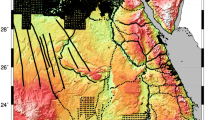Abstract
A precise gravimetric geoid determination requires height information and terrestrial gravity data with high accuracy and resolution. The height data is utilized for predicting mean free-air gravity anomalies as well as computing the topographic, atmospheric and downward continuation effects which are fundamental components of any geoid model. Nowadays the Digital Elevation Model (DEM) obtained from the Shuttle Radar Topography Mission (SRTM) has been widely used when an accurate regional DEM does not exist. In addition the DEM generated from Advanced Spaceborne Thermal Emission and Reflection Radiometer (ASTER) was newly released by researchers from Japan and United States. In this study the effect of ASTER DEM on the estimating mean free-air gravity anomalies in geoid determination were investigated in the Auvergne test area where one of its regions exhibits one of the most rugged topography over the world. The numerical results show that ASTER DEM gives worse statistics than SRTM DEM with respect to the accuracy of the height. Using ASTER DEM introduces discrepancies (compared to SRTM DEM) in the range of \(-\)4 to 10 mGal in the interpolation of free-air gravity anomalies. It is also proven that the geoid differences due to the use of ASTER DEM are a few centimeters, which remain below the accuracy level of the external GPS-levelling data.




Similar content being viewed by others
References
Ågren J, Sjöberg EL, Kiamehr R (2009) The new gravimetric quasigeoid model KTH08 over Sweden. J Appl Geodesy 3:143–153
ASTER (2014) The Advanced Spaceborne Thermal Emission and Reflection Radiometer. http://gdem.ersdac.jspacesystems.or.jp
Bildirici OI, Ustun A, Selvi ZH, Abbak RA, Bugdayci I (2009) Assessment of shuttle radar topography mission elevation data based on topographic maps in Turkey. CaGIS 36(1):95–104
Bjerhammar A (1973) Theory of errors and generalized matrix inverses. Elsevier, Amsterdam
Duquenne H (2007) A data set to test geoid computation methods. Harita Dergisi 18:61–65 Special Issue
Ellmann A (2004) The geoid for the Baltic countries determined by the least squares modification of Stokes’ formula. PhD thesis, Royal Institute of Technology, Division of Geodesy, Stockholm
Ellmann A, Sjöberg LE (2004) Ellipsoidal correction for the modified Stokes’ formula. Boll Geod Sci Aff 63:3
Kiamehr R (2006) Precise gravimetric geoid model for Iran based on GRACE and SRTM data and the least squares modification of the Stokes’ formula with some geodynamic interpretations. PhD thesis, Royal Institute of Technology, Department of Transport and Economics, Stockholm
Kiamehr R, Sjöberg E (2005) Effect of the SRTM DEM on the determination of high-resolution geoid model: a case study in Iran. J Geodesy 79:540–551
Kotsakis C, Sideris MG (1999) On the adjustment of combined GPS/levelling/geoid networks. J Geodesy 73(8):412–421
Merry CL (2003) DEM-induced errors in developing a quasi-geoid model for Africa. J Geodesy 77:537–542
Sjöberg LE (1984) Least squares modification of Stokes and Vening-Meinesz formulas by accounting for errors of truncation, potential coefficients and gravity data. Technical report. Department of Geodesy, Institute of Geophysics, University of Uppsala
Sjöberg LE (1991) Refined least squares modification of Stokes’ formula. Manuscripta Geod 16:367–375
Sjöberg LE (1999) The IAG approach to the atmospheric geoid correction in Stokes’ formula and a new strategy. J Geodesy 73:362–366
Sjöberg LE (2003a) A general model of modifying Stokes’ formula and its least squares solution. J Geodesy 77:790–804
Sjöberg LE (2003b) A solution to the downward continuation effect on the geoid determination by Stokes’ Formula. J Geodesy 77:94–100
Sjöberg LE (2007) The topographic bias by analytical continuation in physical geodesy. J Geodesy 87:345–350
SRTM (2014) Shuttle Radar Topography Mission. http://www2.jpl.nasa.gov/srtm
Tapley BD, Flechtner F, Bettadpur SV, Watkins MM (2013) The status and future prospect for GRACE after the first decade. In: Eos Trans., Fall Meet. Suppl. Abstract G22A–01, pp 330–331
Yildiz H, Forsberg R, Ågren J, Tscherning CC, Sjöberg LE (2012) Comparison of remove–compute–restore and least squares modification of Stokes’ formula techniques to quasi-geoid determination over the Auvergne test area. J Geod Sci 2(1):53–64
Acknowledgments
NASA and METI are cordially acknowledged for providing independent SRTM and ASTER DEMs to the current research. The author would like to give a special thanks to Prof. Dr. I. Oztug Bildirici for his beneficial discussions and criticisms during the compilation of this manuscript. The author appreciates the constructive remarks suggested by two anonymous reviewers in the first version of this paper.
Author information
Authors and Affiliations
Corresponding author
Rights and permissions
About this article
Cite this article
Abbak, R.A. Effect of ASTER DEM on the prediction of mean gravity anomalies: a case study over the Auvergne test region. Acta Geod Geophys 49, 491–502 (2014). https://doi.org/10.1007/s40328-014-0062-8
Received:
Accepted:
Published:
Issue Date:
DOI: https://doi.org/10.1007/s40328-014-0062-8




